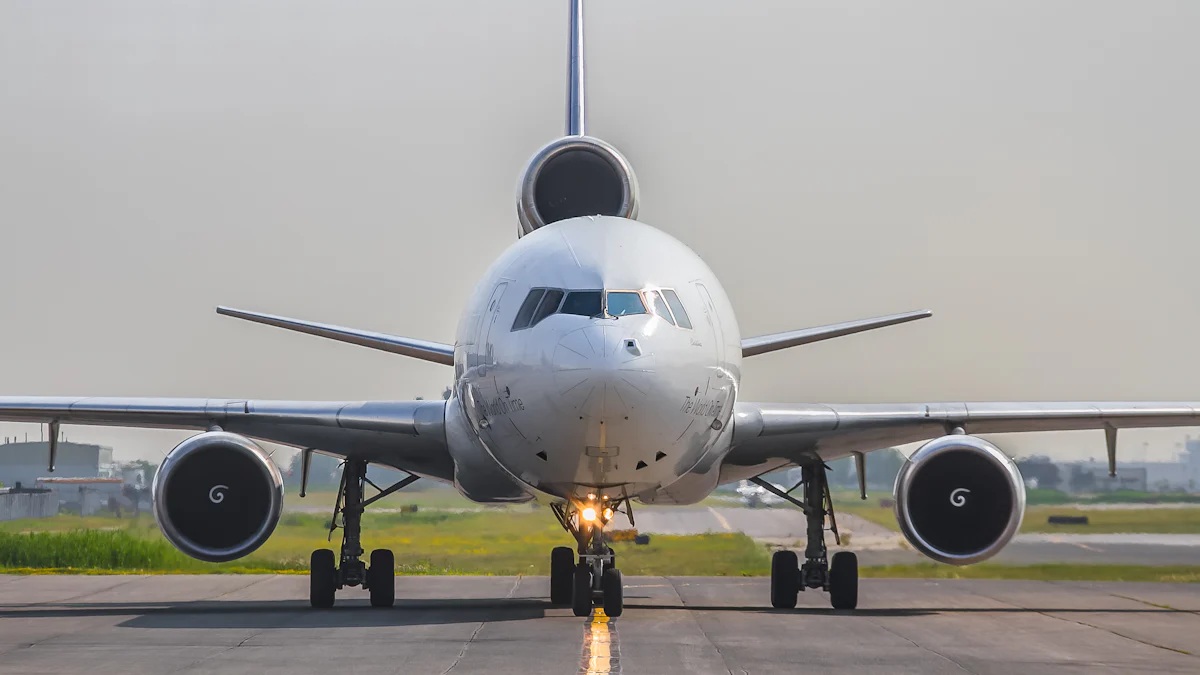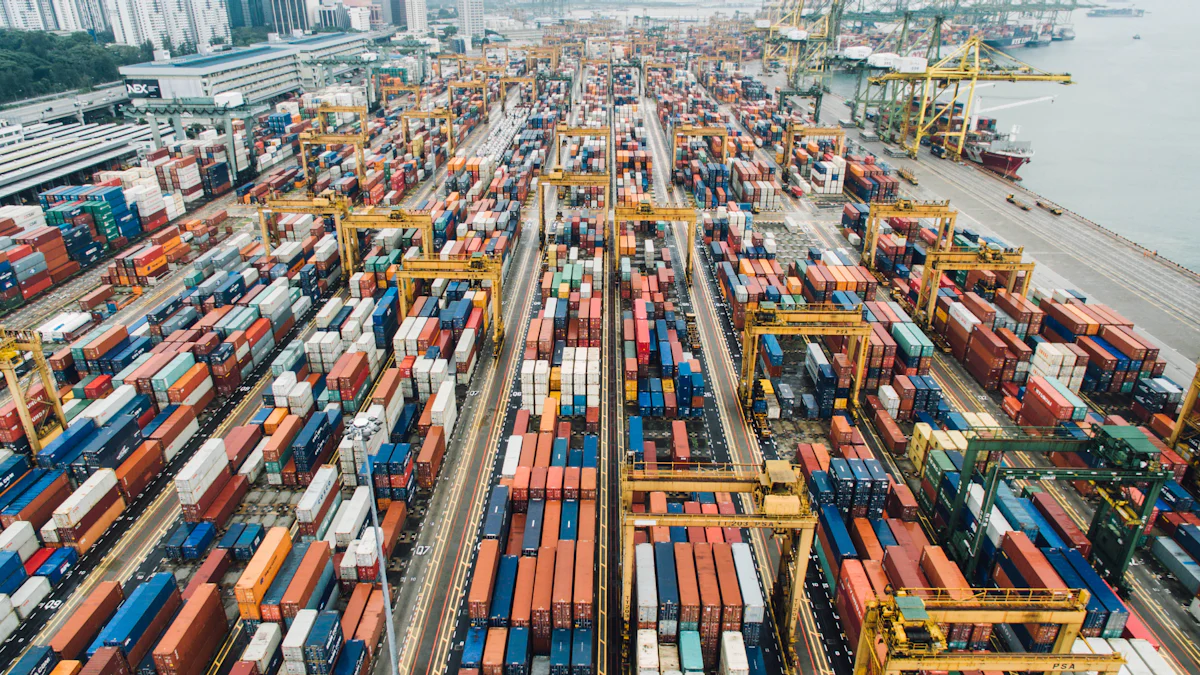Air freight and ocean freight market update

Air freight and ocean freight play a pivotal role in global trade, facilitating the movement of goods across continents with efficiency and precision. Air freight, while accounting for only 3% of global trade volume, contributes to 35% of its value, underscoring its importance in high-value supply chains. Ocean freight, valued at approximately $150.42 billion in 2022, continues to grow steadily with a projected CAGR of 4.6% through 2030. Staying informed about freight market updates is crucial for businesses to navigate market volatility and adapt their supply chain strategies effectively.
Key Takeaways
Air freight, despite its small volume, is crucial for high-value goods, contributing significantly to global trade value.
The Asia-Pacific region is a key driver of growth in the freight market, with strong manufacturing and increasing consumer demand.
Businesses must adapt to geopolitical changes and regulatory impacts to maintain efficient supply chains and avoid disruptions.
Innovations in shipping technology and sustainability practices are essential for companies to stay competitive in the evolving freight landscape.
E-commerce growth is creating substantial demand for air freight services, emphasizing the need for rapid delivery solutions.
Monitoring pricing trends and capacity utilization is vital for businesses to optimize logistics budgets and adapt to market fluctuations.
Proactive planning and the use of digital tools can help businesses navigate congestion and enhance supply chain visibility.
Global Market Overview
Economic Drivers and Challenges
The global freight market continues to evolve, shaped by various economic factors. The Asia-Pacific region leads growth, driven by robust manufacturing and trade activities. China's domestic market is expanding at a pace faster than the global average, reflecting its strong industrial output and increasing consumer demand. These trends highlight the region's pivotal role in global logistics.
Air cargo demand consistently outpaces supply across all regions. This imbalance creates opportunities for businesses to optimize their logistics strategies. The e-commerce industry, in particular, drives significant demand for air freight services. Rapid delivery expectations and the need for efficient cross-border shipping fuel this growth. Ocean freight also faces challenges, including fluctuating fuel costs and capacity constraints, which impact pricing and service reliability.
Geopolitical and Regulatory Impacts
Geopolitical events and regulatory changes significantly influence the freight market. Trade tensions between major economies often lead to shifts in supply chain routes. Businesses must adapt quickly to avoid disruptions. For instance, changes in tariffs or trade agreements can alter the cost-effectiveness of specific shipping lanes.
Regulatory frameworks also play a crucial role. Environmental regulations, such as stricter emissions standards for ships and aircraft, push the industry toward sustainable practices. Innovations in shipping technology and alternative fuels emerge as solutions to meet these requirements. Companies investing in compliance gain a competitive edge while contributing to global sustainability goals.
"The freight market's resilience depends on its ability to navigate economic and geopolitical challenges while embracing innovation," as highlighted by industry experts.
Ocean Freight Market Update

Key Trade Routes and Congestion
Ocean freight continues to face challenges on key trade routes due to increasing congestion. Ports in Southeast Asia and the Mediterranean Sea experience significant delays caused by an imbalance between supply and demand. Consumer demand for goods has surged, leading to heightened pressure on shipping operations. This demand often exceeds available capacity, resulting in bottlenecks at critical ports.
The Red Sea region remains a focal point for congestion, further complicating logistics for businesses relying on these routes. As vessels fill up quickly, companies must plan shipments well in advance to secure space. Efficient route management and proactive planning have become essential for mitigating delays and maintaining smooth operations.
Pricing Trends and Capacity
Global freight rates have shown relative stability, though notable discrepancies exist across trade lanes. Ocean rates originating from Asia remained steady last week. However, mid-month Peak Season Surcharge increases are expected to drive significant price hikes. Strong demand and persistent congestion in certain regions contribute to these fluctuations.
Capacity utilization in the ocean freight market remains tight despite a 10.4% increase in containership supply earlier this year. This tight market dynamic underscores the importance of strategic planning for businesses. Companies must monitor pricing trends closely to optimize their logistics budgets and adapt to shifting market conditions.
Opportunities in Ocean Freight
Innovations in Shipping Technology and Sustainability
The ocean freight sector is embracing innovations to address current challenges and seize new opportunities. Shipping companies are investing in advanced technologies to enhance efficiency and reduce environmental impact. For instance, alternative fuels and energy-efficient vessel designs are gaining traction as the industry moves toward sustainability.
Digital tools also play a pivotal role in modernizing logistics. Real-time tracking systems and predictive analytics enable businesses to make informed decisions and improve supply chain visibility. These innovations not only enhance operational efficiency but also align with global sustainability goals. Companies adopting these technologies position themselves as leaders in the evolving freight market.
"Sustainability and technology are no longer optional in ocean freight. They are essential for staying competitive and meeting regulatory demands," as noted by industry analysts.
Air Freight Market Update

Market Demand and Pricing
The air freight market continues to experience robust growth, driven by increasing global demand. Air cargo rates have remained stable despite disruptions in ocean shipping and rising prices. Since March 2020, air cargo rates have doubled due to constrained capacity and heightened consumer demand. Inbound North America air cargo rates recently registered significant increases, even during the traditional slack season. This trend highlights the resilience of the air freight sector in adapting to market fluctuations.
Air freight prices on China-Europe routes have surged, with an 11.7% increase compared to 2019 levels and a 4% rise compared to 2021. The avoidance of Russian airspace and disruptions in the Chinese market have contributed to these price hikes. Despite these challenges, the market shows signs of stability, with rates from China to Northern Europe rebounding to earlier levels. Businesses relying on air freight must monitor these pricing trends closely to optimize their logistics strategies.
Geopolitical and Economic Impacts
Geopolitical events and economic shifts significantly influence the air freight market. The avoidance of certain airspaces, such as Russian airspace, has altered traditional transport routes, impacting costs and delivery times. These changes require businesses to adapt quickly to maintain supply chain efficiency. Additionally, the global economy's stabilization has led to a steady rise in freight demand, particularly in regions like the Middle East and Africa.
Economic factors, including the rapid growth of e-commerce, continue to shape the air freight landscape. The e-commerce industry has more than doubled since 2018, driving substantial demand for air freight services. The global B2B e-commerce market is projected to reach $36 trillion by 2026, with 80% concentrated in Asia-Pacific markets. This growth underscores the importance of air freight in meeting the logistics needs of this expanding sector.
Opportunities in Air Freight
Growth in E-Commerce and Express Shipping
The rise of e-commerce presents significant opportunities for the air freight market. Consumers increasingly expect rapid delivery, fueling demand for express shipping services. The disruption in ocean shipping has further amplified the reliance on air freight for time-sensitive goods. Businesses leveraging air freight can capitalize on this trend to enhance their logistics capabilities.
Technological advancements also play a crucial role in optimizing air freight operations. Real-time tracking systems and predictive analytics enable companies to improve supply chain visibility and efficiency. These tools help businesses adapt to market changes and meet growing consumer expectations. By embracing innovation, companies can position themselves as leaders in the evolving air freight market.
"The air freight sector thrives on its ability to adapt to changing demands and leverage technology for efficiency," as noted by industry experts.
Regional Insights
North America
The North America market update reveals a complex freight landscape shaped by evolving trade dynamics and economic conditions. Air cargo carriers in this region handle a significant percentage of scheduled international freight ton-kilometers (FTKs). Despite this, the market faces challenges due to an oversupply of capacity. For the past 27 months, supply has consistently outpaced demand, creating a competitive environment for logistics providers.
Transatlantic rates have shown fluctuations, reflecting the region's trade imbalance. The stabilization of the U.S. economy has provided some relief, but businesses must remain vigilant. Efficient planning and adaptability are essential for navigating these conditions. Companies operating in North America benefit from leveraging advanced technologies to optimize their supply chains and maintain competitiveness.
"The North America freight market demands strategic foresight to balance supply and demand effectively," as noted by industry analysts.
Asia-Pacific
Asia-Pacific continues to dominate the global freight market, driven by robust manufacturing and trade activities. This region accounts for a substantial share of scheduled international FTKs, highlighting its pivotal role in global logistics. The dynamic load factor in Asia-Pacific remains higher compared to other regions, reflecting strong demand for air cargo services.
E-commerce growth in Asia-Pacific fuels the need for efficient freight solutions. The region's B2B e-commerce market is projected to reach $36 trillion by 2026, with 80% of this concentrated here. Businesses in Asia-Pacific increasingly rely on air freight to meet rapid delivery expectations. Ocean freight also plays a critical role, although congestion at key ports poses challenges. Companies must adopt innovative strategies to overcome these obstacles and capitalize on the region's economic momentum.
"Asia-Pacific's freight market thrives on its ability to adapt to the demands of a rapidly growing e-commerce sector," according to industry experts.
Europe
Europe's freight market presents a mixed picture, influenced by geopolitical events and regulatory changes. Air cargo spot rates in Europe have experienced volatility, particularly on routes connecting to Asia. The avoidance of Russian airspace has altered traditional transport routes, impacting costs and delivery times. Despite these challenges, Europe remains a key player in global logistics.
The region's focus on sustainability drives innovation in freight operations. European companies invest heavily in alternative fuels and energy-efficient technologies to meet stringent environmental regulations. These efforts align with global sustainability goals and enhance operational efficiency. Businesses in Europe must continue to embrace these advancements to maintain their competitive edge in the evolving market.
"Sustainability and innovation define Europe's approach to overcoming freight market challenges," as highlighted by industry leaders.

JUSDA Solutions
To provide you with professional solutions and quotations.
The air and ocean freight markets continue to evolve, presenting both challenges and opportunities for businesses. Key trends, such as fluctuating freight rates and capacity constraints, highlight the importance of staying informed through a bi-weekly market update. Proactive planning and adaptability remain essential for navigating these dynamics effectively.
Businesses can optimize their supply chains by diversifying shipping methods, leveraging modern technology, and closely monitoring freight rates. These strategies not only enhance operational efficiency but also position companies for long-term success in a competitive market. Regular updates ensure businesses remain agile and responsive to changing conditions.
See Also
Discovering Innovations in Sea Freight Logistics for 2024
Understanding Current Trends in Logistics Risk Management
In-Depth Insights into the Future of LTL Freight
